Table Of Contents
Here’s the truth:
SEO works, especially when your company is targeting professionals, marketing executives, and business owners on the web.
In fact, SEO is the most reliable way for companies to gain online visibility, attract qualified leads, and dramatically increase their customer base and revenue.
Have you ever heard people say that “SEO has become too competitive and ineffective?” Well, so has direct mail, TV commercials, Facebook ads, and so on.
As a digital marketing company, OneIMS has helped a lot of B2B companies including ArmCraft Manufacturing, Artery Capital, Salesforce, ThermoFisher Scientific, and hundreds of other companies to increase their website traffic and revenue. Click here to see video testimonials.
With this wealth of knowledge and years of experience, we know that Search Engine Optimization (SEO) can produce earth-shaking results and it isn’t as complicated as most people think.
It’s actually a simple process that produces results especially for B2B companies that already have a good system (team, organization, resources) in place.
According to survey results published by Search Engine Land, SEO makes the biggest impact on Lead Generation — generating more leads than PPC and social media combined.
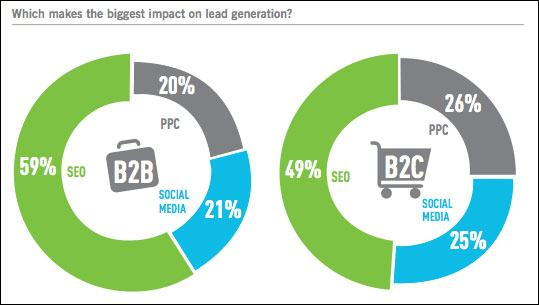
That said, B2B SEO is no longer about optimizing your pages for keywords and building a bunch of low-quality links.
It’s outdated. It’s risky. It’s not ideal for your brand.
The new and effective method is optimizing your company to be visible online for your target audience when they search with different queries.
B2B companies need to take a holistic approach to search engine optimization (SEO). Sure, traditional media still has its place but digital marketing, especially SEO is the most powerful way to reach customers and prospects worldwide.
And it comes at a fraction of the cost of a TV ad, Radio ad, or Direct mail. For traditional ads, you pay once and no media company cares whether or not you get results. All they care about is their money.
They want you to retain your ad slot, which means another money. This can add up pretty quick — sucking your company’s marketing budget with no tangible results to show for it.
So why should your company pay attention to SEO campaigns?
It’s because 61% of all B2B decision-makers start their buying process with an online search, and 71% will conduct their own research first before initiating conversation with a salesperson.
What’s a B2B SEO Strategy?
It’s the process of planning and organizing a website’s content to help search engines easily understand a user’s intent when they’re searching for different queries.
By properly optimizing your web pages around relevant topics (e.g., Los Angeles Attorney, digital photography studio), you can rank higher in the organic search listings for these keywords as well as related keywords.
SEO Benefits For B2B Companies
SEO offers tremendous benefits to all types of businesses.
How did All Metals Fabricating go from having no online marketing strategy to becoming a global brand with a diversified client roster?
Prior to 2008, the contract manufacturing company didn’t invest in marketing.
This was a huge limitation. But when they realized the power of SEO, they embraced it fully and now, they have increased their customer base by over 25%, YoY.
The SEO benefits for B2B companies are enormous. In addition to driving traffic to your website, it offers these other benefits:
i). Improve Long-term B2B Buying Process
Today’s B2B buyers take a different approach when deciding on a product or service to buy. The majority of them will research online for information about the product.
For example, before we invest in email marketing software for our company, I personally read several customer reviews. If you’re like me, you like to compare the products’ features offered by different vendors.
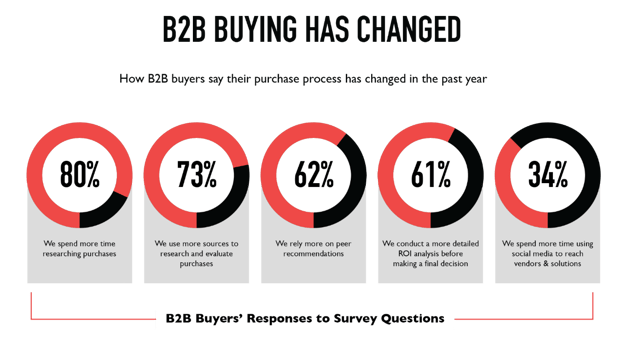
Source: FYNC
When you’re marketing to businesses, there’s ‘this’ complex buying cycle which you must shorten.
That’s why positioning your business’ website in Google through B2B SEO is the ideal way to shorten the buyer’s journey for various search queries.
When B2B buyers find your website at the top of Google, it’d mean you know exactly what you’re doing — after all, one of the best companies in the world (i.e., Google) deem it worthy to show your website on their homepage out of the millions of other websites in your industry.
ii). Gain Traction Online With Content Marketing
There may be several ways to improve a company’s visibility in the search engines results pages, but content marketing is preferred by most companies because it produces great results.
Jeff Bevan shared a success story of how content marketing powered by Clickx’s tool helped his company to generate traffic, acquire and track leads, and win customers.
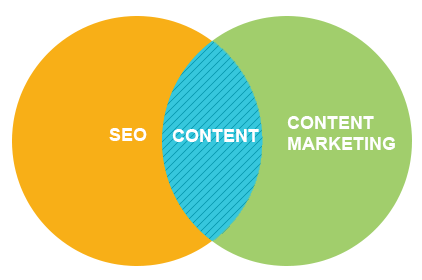
Salesforce, Infusionsoft, Xerox, T-Mobile, and several other companies invest mostly in digital marketing strategies with a focus on Search Engine Optimization. Why? Because they can do the work once and reap the rewards for years.
Content marketing is tricky if you’re expecting an overnight result. You’ll become relevant in your niche and see dramatic results when you stay consistent and document your strategy.
By creating helpful content on your blog, you attract company’s decision makers. They come to your content and will do something else while they’re there.
According to Lee Odden, an industry leader in search engine marketing:
“SEO works as the mayonnaise for the sandwich of content marketing.”
It’s a decision to help your audience with meaningful content. Make sure the content addresses their search queries.
If a client is searching for “best project management solutions,” for example, then your page should richly address that keyword and provide answers.
Your content must be helpful. It doesn’t matter whether or not the reader signs up to your email list, calls your customer care line, or buys your product, they should be happy and fulfilled just by reading your content.
Use SEO to enhance your content’s value. Content marketing establishes your company as a thought leader in your industry. It gives people the ‘chance’ to take interest in and to trust your products/services.
iii). Mobile Visibility
Today, mobile traffic is bigger than desktop traffic. People are using mobile devices (Smartphones and Tablets) every single day, even in their offices. They also make purchases using their mobile phones.
When your site is optimized for mobile devices, it means you can attract users who are targeted and often makes purchases on the go.
If you produce media content (such as videos, slide presentations, podcasts, etc.), then you’ll engage your mobile audience better. After all, the average mobile user consumes 6 hours of media per day.
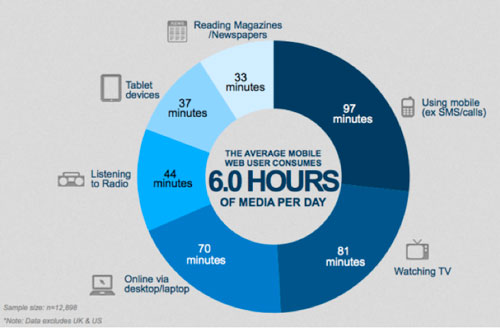
If you’re a WordPress user, then you can use a modern theme that makes your website to display properly on any mobile screen no matter the size.
Since a lot of executives and business managers conduct research online via mobile devices, you can easily reach them in real-time and convert them into customers.
iv). Beat Your Competition in The Organic Search
Some B2B companies are lazy to implement SEO.
Don’t feel sorry for them. Just take action to dominate the market. It’s your time!
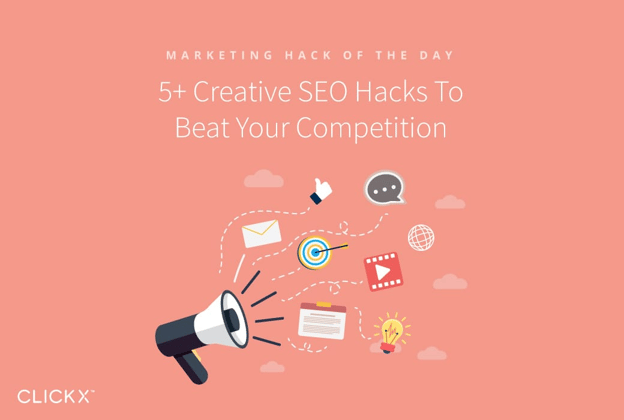
It doesn’t matter how many companies are offering the same products or services, if they’re not taking advantage of search engine marketing for their website, then it’s your chance to dominate Google top 10 organic results.
By developing an effective SEO strategy for your company’s website, you can increase your brand’s image.
Focusing on SEO campaigns is important because it’ll make your website more visible in the top organic listings and attract clicks from the target audience.
And remember that the more clicks your website gets, the more traffic you’ll receive on your website. This could translate into leads and sales.
B2B SEO Statistics and Trends
Business executives don’t make decisions emotionally, data is what they rely on. Credible statistics are essential for choosing to either invest in B2B SEO or use other marketing tactics.
Through these data, you can even decide to focus 100% on search engine optimization.
Whatever the case, here are some striking B2B SEO statistics for your company:
1). Approximately 50% of search terms contains four words or longer.
This shows that online users are searching for specific information in Google. They’re no longer using a generic search query such as “cloud web hosting.”
Instead of using this popular but vague search query, they’d rather type in “best cloud web hosting solution” into the search bar.
According to a study by Moz, long-tail traffic generates more than 70% of all search traffic.
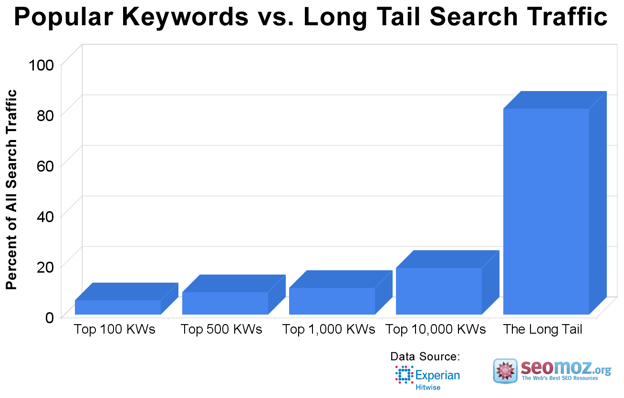
Your SEO strategy should be based on long-tail keywords.
Even if you have a huge budget for content creation and link building (two factors that help you rank better in Google), the best approach for B2B companies is to target long-tail keywords with four words or longer.
2). More than 300% web traffic comes from search engines
Although Social media is great for building brand awareness, initiating discussions, and engaging the customers — it sucks at driving targeted traffic to websites.
It doesn’t come anywhere close to the Search engine. Whether it’s traffic generation or most converting traffic, the organic search performs better than other channels.

Source: Pinterest
Remember that people who search for information on Google are either ready to buy a product, or become loyal readers, at least.
3). More than 70% of search traffic comes from long-tail keywords
Long-tail keywords are easier to rank in Google.
They are targeted search queries that will bring you customers. Short-tail keywords (which are usually popular and contains fewer than 4 words) are too competitive.
As a digital marketing agency, we know how competitive that search term is, so we don’t mess around with it.
But instead, we target long-tail keywords such as “best digital marketing company”, “B2B online marketing agency”, etc.
Although these long-tail terms are fairly competitive, they’re a lot easier to rank for. There’s no chance of outranking more established websites for seed terms.
4). 45% of companies say they highly integrate content marketing with their SEO strategy
Content marketing is mostly used to lubricate the SEO engine. Without content, there’s no effective way to deploy a winning SEO campaign.
In like manner, your content’s visibility online is greatly enhanced when your website pages rank high in Google organic results.
Given the effect of ‘content’ on search visibility, 39% of B2B companies will increase their content marketing spending in the next 12 months.

5). 20% of search terms users typed into Google search bar have never been searched before.
Your business can’t ignore SEO because your target audience is using it every day. Your lead generation system will likely tank if you ignore your search audience.
20% new terms every single day is an opportunity to achieve more visibility in the search.
6). 20% of search queries are voice searches.
It gets exciting when you consider how much your prospects use their mobile phones. This data is telling you to pay attention to your content.
Target conversational keywords, for example, “how do I integrate Salesforce with Zapier.”
This isn’t just a long-tail search term, it’s also conversational and personal. Create useful content that answers the question. Perhaps, you can use ‘step-by-step’ approach or listicles to format the article.
That’s the type of content that Google serves to voice users on mobile.
Focusing only on desktop users means you’re leaving a lot of leads and money on the web. You wouldn’t want that to happen to your business, would you?
Voice searches will rule the future of search. Research shows that by 2020, 50% of all searches will be voice searches.

B2B SEO Tactics & Strategies
Before we dive into the strategies and tactics, understanding what B2B SEO entails is necessary. Before you can successfully gain online visibility, your digital marketing hire must cover these 3 categories:
-
On-Page SEO
-
Off-Page SEO
-
Technical SEO
On-Page SEO
This is arguably the most important category because it defines everything that happens on your company’s website and blog.
It boils down to the steps you’re taking to improve user experience on your website.

On-Page SEO is often referred to as “content SEO” because that’s the ultimate focus — to create the best content and make it easily accessible to users.
It also takes care of keywords, titles and meta descriptions, internal linking, design, etc.
Off-Page SEO
When you other websites link back to your page, that’s a form of off-page SEO because it tells Google how useful your page is.
It’s to be valuable otherwise no other website would have considered linking to it.
Backlinks help a page to rank better and higher (not faster) on Google organic listings.
Your business is going to invest time and money to build/earn links.
There are other aspects of off-page SEO (e.g., business listings, brand citations, domain-level brand features), but inbound links from other web pages pointing to your page are the most important factor.
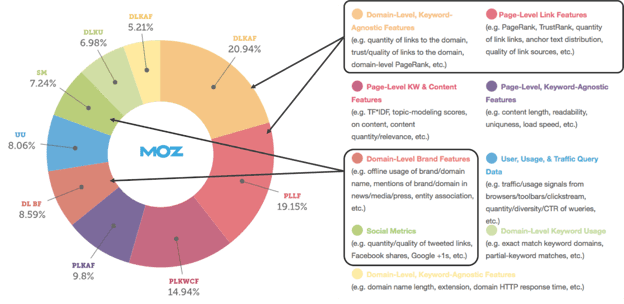
That’s why to a lot of founders, professionals, and marketers, off-page SEO simply means link building.
Technical SEO
This is what web developers would refer to as the “back-end” of an application. Users don’t see it but it’s the framework of the website.
Technical SEO makes sure your website is easy to crawl and indexed, as well as well structured for the user. Some of the technicalities you’d come across are SSL, Sitemap, Robot.txt, Schema, AMP, Page Speed, Canonical, etc.

Source: SEJ
All of these categories work seamlessly with one another to help a website to perform well in the organic listings.
For example, when you create long-form content, you’ll naturally target many keywords and attract more trusted links from authoritative websites.
That’s a combination of on-page and off-page SEO.
None of these SEO categories are specific to B2B, hence the rest of this post will cover extensively on off-page SEO.
Our goal is to make B2B company’s website visible online and easily accessible on Google when professionals and top business executives (including founders) search with different search queries.
4 Powerful B2B Tactics and Strategies You Can Implement Right Now
Keyword Research and Competitive Audit
This is where it all begins. You need keywords that your target audience are typing into the search engines. But you’re going to piggyback on your competitors’ best strategies to steal their rankings (legitimately).
This may seem like a common practice, but not too many B2B companies are doing it.
When we take on a new B2B client, we usually ask them a few questions to determine how far they know their audience and market.
Surprisingly, the majority of them don’t have a complete understanding of who they’re really serving and what those people are searching for.

Bear in mind that a given keyword could apply to both B2C and B2B customers. That’s why drilling down into the minds of your audience is essential.
For example, the keyword “cloud hosting” could represent:
- An individual looking to invest in cloud hosting
- An enthusiast looking for a cloud hosting service for his fun project
- A CEO or founder looking to buy a cloud hosting solution for his company.
As you can see, the keyword can be useful for individuals and businesses alike. You want to target some of these keywords that not only applies to businesses, but also to individuals who would like to enjoy what organizations are enjoying.
You never can tell.
The only issue with the keyword “cloud hosting” is its nature. It’s too generic and doesn’t show exactly what the searcher is looking for.
That’s why you need to segment out the user types before creating your content. Better yet, make it clear that your offer is for “businesses” and not for “individuals.”
Don’t be deceived by the term “B2B keywords research.” Why? Because businesses don’t type in keywords into Google search bar, individuals do.
To find the right keywords that are specifically targeting your ideal customers, let’s use Ahrefs to find a few keywords.
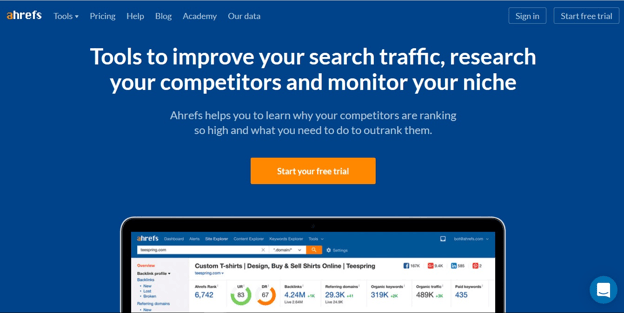
Instead of wasting time trying to find the right keywords, why not leverage your competitor’s best keywords.
To do this, enter your competitor’s website address (e.g., HubSpot.com) into the Ahref’s search bar and hit “enter” on your keyboard.
Next, click on Organic Keywords:

Next, filter your results to find long-tail keywords (with 4 words to 9 words) with a decent search volume. Also, make sure you set the Keyword Difficulty (KD) to 3 or less.

Finally, scroll down the page to find keywords that you can target, assuming your business is offering similar products as HubSpot’s.
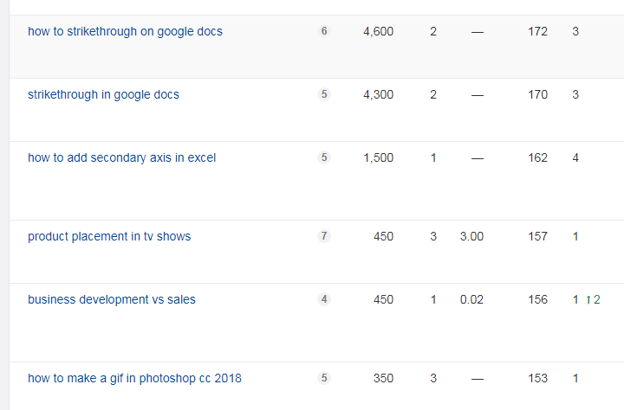
Alternatively, you can find great keywords just by adding the ‘alternative’ modifier to your competitor’s brand name.
Yes, prospects are always looking for alternative solutions. So you’re not manipulating search queries, just taking advantage of the hard work that your competitors have done over the years.
So, in the Ahrefs Keywords Explorer, enter “Freshbooks Alternative.” We’re assuming your business offers accounting solutions for small businesses.
Here’s the result:
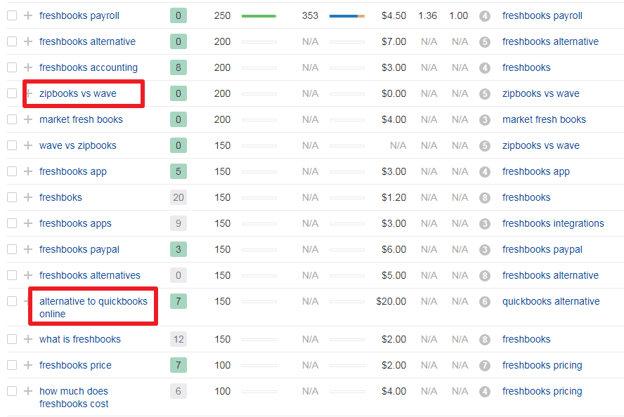
When you audit your competitor’s website, you’ll discover a lot of keywords to target in your pages.
Instead of optimizing your pages for entirely new keywords that are competitive, you should follow what the market is doing — especially when they’re ranking higher than your company’s website in the organic search results.
Build Marketing Funnels
Most companies are making a terrible mistake. How?
They’re trying to sell their products and services all the ALL THE TIME.
All they care about is that immediate gratification as soon as a visitor lands on their website. They use all manner of persuasion tricks, incorporating video, offered coupons, and even promised 24-hour customer support.
In the end, they end up frustrated.
The truth be told: that’s not how to do marketing online.
It could work offline with direct mail, TV ads, or newspaper ad, but in the online environment, every business (whether B2B or B2C) needs a marketing funnel.
Here’s another case scenario:
You walk into a clothing store and touched a T-Shirt that you really like. The moment you that store, a salesperson is already waiting to get your payment. He or she walks up to you and asks, “will you pay with cash or credit card?”
Tell me, will you be happy with the salesperson? I doubt.
You needed to make a decision right there. Maybe you were ready to test the shirt but got interrupted by that desperate salesperson.
To avoid sounding pushy and ineffective, every business that’s building online visibility via search engine optimization or even social media needs a Marketing Funnel.
If you’re a decision maker in your company or you occupy an important position, you should educate the top executives.
Let them know that generating customers and revenue is usually a multi-step process.

It requires a steady and progressive approach. During this process, you nurture prospects and get them ready to make a purchase.
For example, when a shoe salesperson asks for your size, color preference(s), and even helps you try a few pairs on, that’s nurturing. If they inform you about the deal, then that’s the icing on the cake.
When you’re armed with relevant and adequate information about the item you want to buy, then you can easily make informed decisions.
That’s exactly why you need marketing funnels for your campaign.
For some of our B2B clients that don’t have a marketing funnel, we make sure we start with that.
It doesn’t make sense sending traffic to a company’s homepage without making adequate provision for lead nurturing.
In essence, a marketing funnel is a system a business uses to capture website visitors and turn them into customers.
There are so many forms of marketing funnels, but we like to keep it simple with this funnel-like model, courtesy of Shopify.
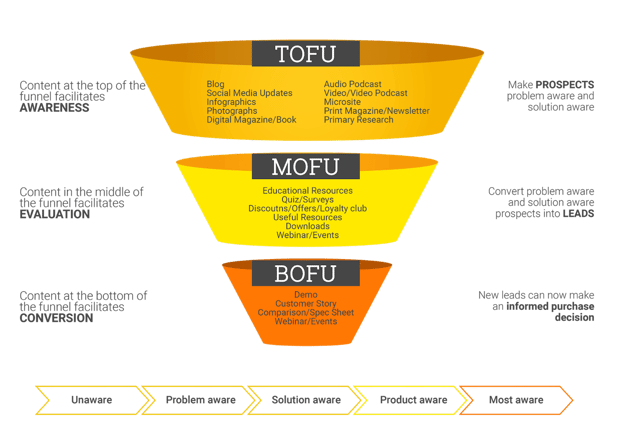
As you can see, there are 3 categories:
-
Top of the Funnel (ToFU)
-
Middle of the Funnel (MoFU)
-
Bottom of the Funnel (BoFU)
i). Top of the Funnel: This is where a company creates awareness. It’s usually the stage where demand generation is critical.
Most of your ideal customers don’t know your company exists yet, so, don’t ask them to buy your product or service.
Come on, they’re just getting to know that your company actually exists!
Maybe they just watched your YouTube video or read your blog post. Perhaps they interacted with your quiz or contest.
It’s even possible they found your page on Google results when they searched for a query.
Middle of the Funnel: This is the stage of the marketing funnel where establishing trust with prospects is required. You want people to start showing interest in your brand and/or your offers.

It’s your responsibility to provide enormous value that will inspire blog readers, video viewers, and brand admirers to consider subscribing to your company’s newsletter.
Once they fill out a form and submits their contact information (such as email address and first name), they have automatically become leads that you can follow up on.
In the middle of your marketing funnel, you start building relationships. If your approach is effective and transparent, you could get a few people to buy your product.
It could happen but don’t count on it.
Give away plenty of free resources (e.g., white paper, videos, free tool, cheat sheet, swipe files, templates) so that people can easily opt-in to your contact list to get the free resource.
Teachable gives away a free course creation book as a way of capturing leads and nurturing marketers who are interested in launching an online course.
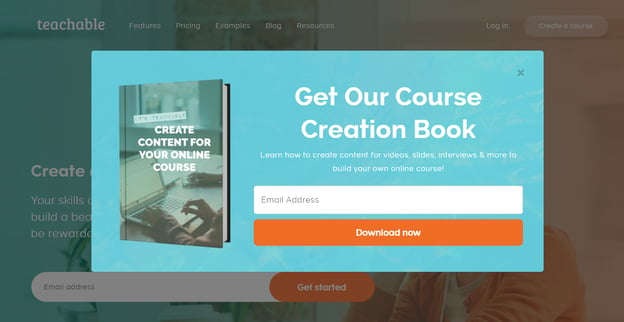
ii). Bottom of the Funnel: If you’ve done a good job at the consideration stage (i.e., middle of the funnel), then nothing should stop you from recommending your product at this point.
With the level of trust you’ve built, present your main offer to them.
Make your offer compelling, invaluable, and let people perceive it as the only solution to their challenge or problem.
If you’re an innovative company, a limited-time offer for your product would increase conversions at this stage.
Content Creation & Content Promotion
Nothing comes close to an effective content marketing strategy.
A lot of companies don’t invest in top-notch content, and their CEOs are the first to claim that digital marketing strategies don’t work.
Content marketing, in particular, is an umbrella term that covers everything from understanding the target audience to create useful content to promotion and revenue generation.

It’s a process that brings business to the forefront; pushing it past the teething stage, and making sure the target audience finds it online.
However, not all content types are created equal. What your company needs more than anything is high-quality content.
That’s the type of content that drives brand awareness, generates leads from organic search traffic, and establishes the company as the best in the industry.
Don’t create any mediocre content. It’ll fail and your company will not achieve its aim.
But instead, focus on creating content that truly ‘nudges’ the prospects through the buyer’s journey, educating, informing, and reinforcing relationships from the top of the funnel to the bottom.
Your company also needs to have the right technology in place to manage the content. Sadly, only 18% of B2B marketers feel their organization has invested enough in content marketing tools.
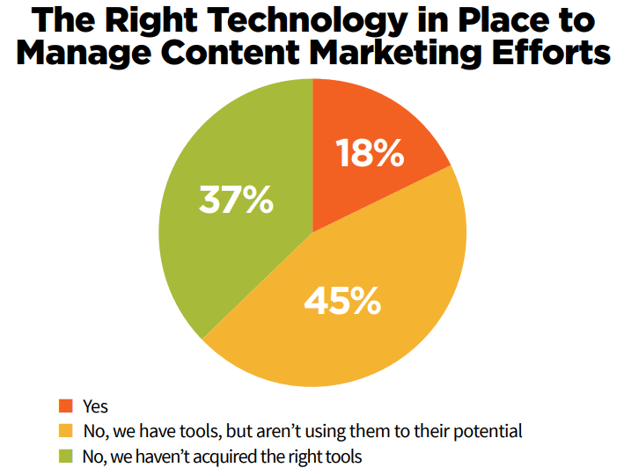
If your company serves multiple audiences, then it’s important to map out your ideal customer profile. That way, you can create an effective content that will appeal to each audience type.
Refine your content strategy to focus on the right audience for a given campaign.
Here’s a great example:
Crowe Horwath, a public accounting and consulting firm with a varied customer base wanted to increase online visibility and drive customer engagement.
The marketing team developed a technique that allowed them to narrow down and target C-level prospects in financial institutions with $1 billion or more in assets.
With their strategic content plan, they created a helpful content plan that covers four specific content areas by leveraging different content types (white paper, infographics, video, case studies, and some executive briefs).
Take a look at the infographic they created:
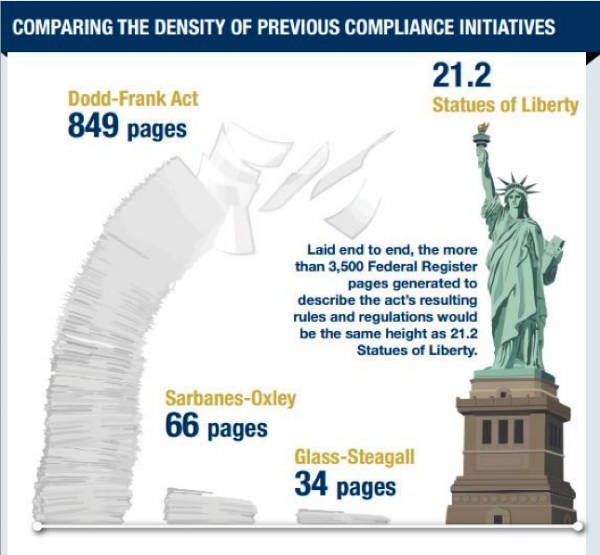
All the different content formats they created addressed a common issue for their target audience: compliance with financial regulations.
Aside from all the new leads they generated from white paper downloads, the infographic alone generated $250,000 in revenue for the company.
If you follow this approach, you’ll always get results from your content marketing efforts. Understand what your audience ‘wants’ and ‘needs’ are, and fill the gap with rich and useful content.
Link Building
Link building is the icing on your content marketing campaign. Google sees links as a vote of thanks for websites.
If BBC, for example, cites your company’s website and actually links to your homepage or any page at all, Google will reward you accordingly.
Although that link may be no-follow; which means Google doesn’t reward it as much as a dofollow link.
But since BBC, is a trusted media site, it’ll drive traffic to your website which would indirectly increase on-page activity.
1. Create helpful resources
So many link building tactics are termed ‘blackhat’ because they go against Google’s terms of service.
Hence, it’s important to stick to legit and trusted methodology when it comes to earning links that will improve your company’s visibility in the organic search results.
Creating compelling resources that your competitors can’t easily create would earn you inbound links. Since they can’t create it, they’ll simply link back to it.
For example, GetResponse created a resource infographic titled “Landing Pages in Southeast Asia,” and the company uses it for email outreach, lead generation, and link building.

Producing the right content takes time and money. Companies should have a set budget, not only for content creation but also for link building.
Resources that attract natural links are unique, educational, informational, and engaging. The beauty of it is you can use it as a guest post on several industry blogs.
If the resource is an infographic, then you can contact industry experts to consider featuring it their blogs.
If you pitch 100 bloggers and 25 of them agrees to feature your resource content, then that’s a huge milestone that would kick-start your link building campaign.
25 links from unique domains CAN boost your search rankings. In fact, depending on how competitive your industry is, there’s a chance that your website will rank at number #5 position or even higher.
To make each infographic unique across different websites, add a unique introduction (between 200 – 700 words) to the infographic. That way, Google will crawl the page and serve it to the right audience.
In turn, you’ll link to your website from within the content (i.e., contextual link).
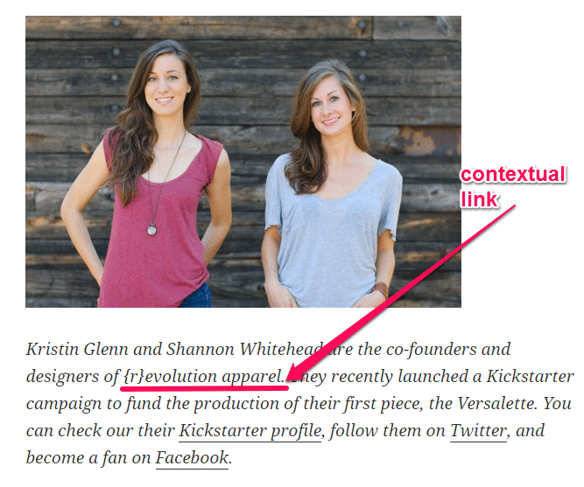
2. Fixing broken links on trusted blogs
Online entrepreneurs are fond of linking out to other websites. Can you imagine how many websites I have linked out to from this epic guide?
Now, what happens when a site no longer exists (due to web hosting issues or maybe the site has been hacked by ‘those’ guys)?
If the site no longer exists, it will return a 404 error page whenever someone clicks on the link. 404 error pages or broken links are ‘dead’ and doesn’t promote a good user experience. Google frowns at it.
One of the steps you can take when building links is to help website owners and companies identify these dead links on their pages, then recommend a replacement link (i.e., your own valuable content).
Use Broken Link Checker to find all the dead links on a page you’d link your company’s website to appear.
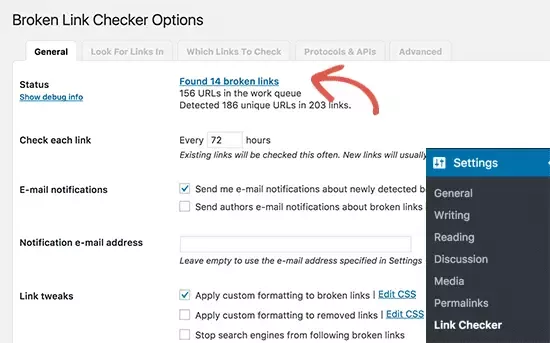
Next, send a personalized email to the site owner or author. Show them the broken link and quietly recommend your page (make sure it’s relevant to the dead link) as a replacement.
That’s another way to get powerful links that will improve your search rankings. This is time-consuming and boring.
You may not have the inclination to find these dead links, but you can always hire contractors to handle it.
3. Link Reclamation
We’ve built a lot of high-quality links with this strategy. Link reclamation, as the term suggests, means to earn a worthy link for your brand mention on another website.
Tim Soulo explains it better in his comment:
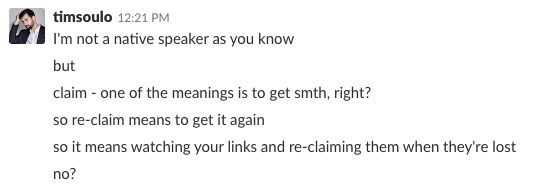
Here’s how it works in brief:
You use Mention or any third-party tool to find websites, blogs, and publications that mentioned your brand name or product name without linking to it.
Once you find these mentions, reach out to the blog author or editor and kindly re quest they reference the appropriate on your website via a link.
Here’s why it works:
The publication has already mentioned your brand, which means they trust you to an extent. Simply asking for a proper link isn’t strange. After all, it’s your brand we’re talking about here.
Here’s a post excerpt where Crowe Horwath was mentioned but no link. If the company sends an email to us, we might give them a link.

Note: We’ll cover extensively on link building strategies for B2B companies in our subsequent guide. Request your Growth Strategy Session today.
Let’s guide you on how to increase online visibility for your company — in order to generate qualified leads and revenue.
Final thoughts
When it comes to B2B SEO, content is essentially the driving force of success irrespective of the campaign you’re running.
If you want authoritative websites to drive traffic and leads to your marketing funnel, then you need high-quality content. You need content on your blog to engage visitors.
You don’t only need ‘quality’ but also ‘volume.’ That means your company has to produce a lot of helpful content.
All in all, personalizing your clients’ experiences will be key components in marketing campaigns, plans, and strategies in the new year.
Personalized content that addresses people’s pain points and speaks to them individually will lead to more conversions.
In other words, don’t speak to your target audience as a group but as individuals.
After all, a group of people (or company) don’t search for products and services on Google at the same time, individuals (such as a manager, CMO, an executive) do!
Hence, every business must capitalize on this trend when optimizing their pages for search users, when selecting keywords and building links, and of course, when creating content.
That’s how to take your B2B SEO strategy and lead generation to new heights this year, and far beyond.





